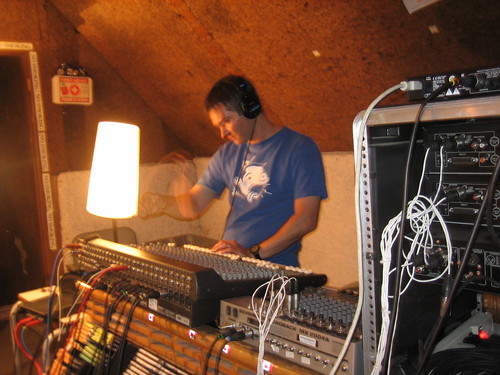Abstract Index Playlist - February 6/08

I'll just quote myself: my intro to MFSB's "Love Is The Message" on the air was "it's one of the great unity songs of all time".
I was sure looking for some sort of unity this past Wednesday. As you already know, it's Black History Month, and once again I didn't know how to approach it. I've done different things over the years including special interviews and thematic programming, as well as participating in other hosts' broadcasts and station-wide initiatives.
I decided to play mostly Black artists on Wednesday - I couldn't devote the whole show due to Jean Martin's interview and his jazz music! ;) - and inevitably I found myself going through discs asking myself "Is this artist Black?" My disc of the week would have been a new release of old school merengue, but I couldn't tell whether La India Canela was of African ancestry. The music sure is, but beyond that I didn't know so I didn't play it. For sure Mr. Something Something wouldn't have counted, despite their profound knowledge of African music. But could I have played their most recent album with Black Afrobeat poet Ikwunga?
(When I interviewed them in December I asked that very question; whether having a Black vocalist gave them greater credibility in some eyes. What actually transpired was that he had sought them out rather than the other way around . He was blown away by their originality with all the components of Afrobeat - he wanted to collaborate with a forward-thinking band that suited his style.)
These questions have the effect of limiting what I feel I can do with the show, and with the considerable African diasporic content that's within it from week to week (to those who say "why can't Black History Month be 12 months a year?", I agree). What I try to do each time out is to present a mixture of musical styles, eras and points of origin that speak to these different mixtures. It's about comparing and contrasting; reaching for commonalities while examining differences. Music of African derivation (especially Afro-American music) has become part of almost every popular music form around the world, and some of the most amazing hybrids come from previous hybrids recombining in different locales. Afro-diasporic music underlies the great majority of the music I play, and what I write about. That said, the Abstract Index isn't strictly about the African diaspora - it's about every diaspora. It's about how culture, economics and population collide in often surprising and counter-intuitive ways to make interesting sounds. Naturally, it's also a personal exploration and education.
"Love Is The Message" is one of those important points of junction - it's a song that looks backwards and forwards. Originally recorded in 1972 by the Sigma Sounds (multiracial) studio orchestra under the guidance of Gamble and Huff, this was one of the key symphonic soul records. Studio orchestras had been around for 50 years plus, and Gamble and Huff's arrangers, players and even songwriting devices ("Me And Mrs. Jones", anybody?) looked back to far earlier days. In some ways the production process for big budget recording had not changed in decades, it just got bigger - the spirit of Tin Pan Alley and the Brill Building (where Huff had worked) were still alive and well.
But this song was also a turning point, at least as a remix by Tom Moulton in 1977. The first 6 minutes are pleasant enough with the Three Degrees cooing along in the background to a saxophone right out of "Theme From Family Ties", but then the vamp drops in for the last six and a half minutes. Broken down to Earl Young's hypnotic drumming, Bobby Eli's bass, a flanged electric piano, horn shots and a minimalist string hook, this was the beginning of house music. The EQing is just perfect - the rhythm wouldn't be so addictive were it not for its sharp focus in the mix. As was Moulton's method, this version involved stripping records down rather than keeping them at peak levels while somehow trying to add more. The vamp itself became classic - vibraphonist Vince Montana reused the basic template for a whole bunch of Salsoul Orchestra records, which were influential in their own right, and the Jungle Brothers classic "What U Waiting 4?" updates early MCs like DJ Hollywood rapping over disco rather than funk breaks.
The appeal of the spare, extended rhythm pointed the way towards sequencer-driven music. The ability of one person to do the work of an orchestra was revolutionary, but one consequence was the collective ability in jazz, blues and pop contained in a studio orchestra was no longer an ingredient in the music making process. I'd argue that the Philly International folks were among the last practitioners of this kind of grand studiocraft, subsequent dance grooves were just that - about the groove first and not beholden to any songwriting tradition. But therein lies a whole new set of possibilities - as the following track, Cybotron's "Clear" makes, uh, clear.
Hour 1 podcast
Hour 2 podcast
love is the message - MFSB (cbs)
clear - cybotron (network)
optometry - dj spooky rmx. by animal crackers (thirsty ear)
business before pleasure - george akaeze & his augmented hits (soundway)
cat song - jean martin/colin fisher (barnyard)
sandwiches and a dip in the pool - jean martin/evan shaw (barnyard)
psychiemotus - yusuf lateef (impulse)
quebec on my mind - billy robinson (do right)
jiggy jiggy - steve reid (domino)
keep on moving - bob marley & the wailers feat. wong chu (JAD)
here I come - dennis brown (JA)
islington rock - augustus pablo (shanachie)
peace treaty - jackie mittoo (blood and fire)
solid ground - michael rose (m)
i don't need nobody killing me - ljx (no label)
Labels: interviews, playlist, soul/R+B


0 Comments:
Post a Comment
<< Home